Electronic Health Record System Analysis: Headspace Project Report
VerifiedAdded on 2020/03/28
|11
|2099
|209
Report
AI Summary
This report provides an analysis of the Headspace Electronic Health Record (EHR) system, focusing on the perspective of a business system analyst. It begins with an executive summary and a table of contents, followed by an introduction to the Headspace organization and its focus on young people with mental illness. The report details the stakeholder map, describing internal and external stakeholders and their roles. A questionnaire designed for patients is presented, including the introduction statement and relevant questions. The report then includes a use case diagram and descriptions of each use case, with a fully developed use case and the identification of 'registration' as a crucial use case. The conclusion summarizes the key findings, emphasizing the importance of the stakeholder map, the questionnaire for gathering information, and the use case diagrams for system design. References to the sources used in the report are also provided.

Running head: ELECTRONIC HEALTH RECORD SYSTEM
Electronic health record system
(Headspace)
Name of the student:
Name of the university:
Author Note
Electronic health record system
(Headspace)
Name of the student:
Name of the university:
Author Note
Paraphrase This Document
Need a fresh take? Get an instant paraphrase of this document with our AI Paraphraser

1ELECTRONIC HEALTH RECORD SYSTEM
Executive summary
The report analyses the stakeholder maps along with developing the questionnaire. All these are
done from the perspective of the analyst of the Headspace project. A use case diagram is also
included along with its brief description.
Executive summary
The report analyses the stakeholder maps along with developing the questionnaire. All these are
done from the perspective of the analyst of the Headspace project. A use case diagram is also
included along with its brief description.

2ELECTRONIC HEALTH RECORD SYSTEM
Table of Contents
Introduction:..........................................................................................................................................2
1. The stakeholder map:.........................................................................................................................2
1.1. The required stakeholder diagram:.............................................................................................2
1.2. The stakeholders and its description:..........................................................................................3
2. The required questionnaire:...............................................................................................................4
2.1. The determination of the stakeholders to send the following questionnaire:.............................4
2.2. The introduction statement:........................................................................................................5
2.3. The relevant questions to the patients:........................................................................................5
3. The use case diagrams and descriptions:...........................................................................................6
3.1. The use case model:....................................................................................................................6
3.2. Description of every use case:....................................................................................................7
3.3. Description of the fully developed Use Case:............................................................................8
3.4. One of the important Use cases identified:.................................................................................8
Conclusion:............................................................................................................................................9
References:..........................................................................................................................................10
Table of Contents
Introduction:..........................................................................................................................................2
1. The stakeholder map:.........................................................................................................................2
1.1. The required stakeholder diagram:.............................................................................................2
1.2. The stakeholders and its description:..........................................................................................3
2. The required questionnaire:...............................................................................................................4
2.1. The determination of the stakeholders to send the following questionnaire:.............................4
2.2. The introduction statement:........................................................................................................5
2.3. The relevant questions to the patients:........................................................................................5
3. The use case diagrams and descriptions:...........................................................................................6
3.1. The use case model:....................................................................................................................6
3.2. Description of every use case:....................................................................................................7
3.3. Description of the fully developed Use Case:............................................................................8
3.4. One of the important Use cases identified:.................................................................................8
Conclusion:............................................................................................................................................9
References:..........................................................................................................................................10
⊘ This is a preview!⊘
Do you want full access?
Subscribe today to unlock all pages.

Trusted by 1+ million students worldwide
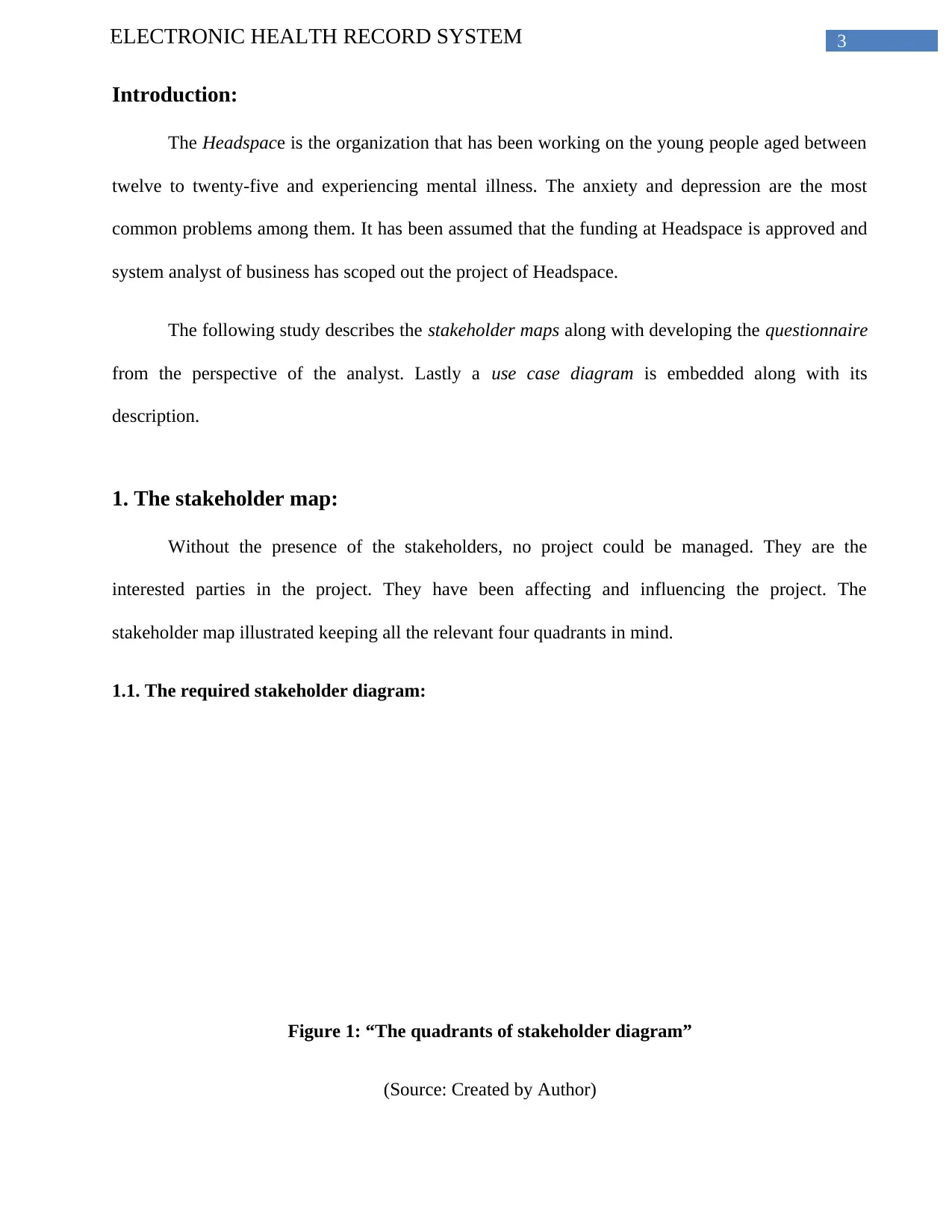
3ELECTRONIC HEALTH RECORD SYSTEM
Introduction:
The Headspace is the organization that has been working on the young people aged between
twelve to twenty-five and experiencing mental illness. The anxiety and depression are the most
common problems among them. It has been assumed that the funding at Headspace is approved and
system analyst of business has scoped out the project of Headspace.
The following study describes the stakeholder maps along with developing the questionnaire
from the perspective of the analyst. Lastly a use case diagram is embedded along with its
description.
1. The stakeholder map:
Without the presence of the stakeholders, no project could be managed. They are the
interested parties in the project. They have been affecting and influencing the project. The
stakeholder map illustrated keeping all the relevant four quadrants in mind.
1.1. The required stakeholder diagram:
Figure 1: “The quadrants of stakeholder diagram”
(Source: Created by Author)
Introduction:
The Headspace is the organization that has been working on the young people aged between
twelve to twenty-five and experiencing mental illness. The anxiety and depression are the most
common problems among them. It has been assumed that the funding at Headspace is approved and
system analyst of business has scoped out the project of Headspace.
The following study describes the stakeholder maps along with developing the questionnaire
from the perspective of the analyst. Lastly a use case diagram is embedded along with its
description.
1. The stakeholder map:
Without the presence of the stakeholders, no project could be managed. They are the
interested parties in the project. They have been affecting and influencing the project. The
stakeholder map illustrated keeping all the relevant four quadrants in mind.
1.1. The required stakeholder diagram:
Figure 1: “The quadrants of stakeholder diagram”
(Source: Created by Author)
Paraphrase This Document
Need a fresh take? Get an instant paraphrase of this document with our AI Paraphraser

4ELECTRONIC HEALTH RECORD SYSTEM
1.2. The stakeholders and its description:
Quadrants Stakeholders Description
Internal
operations
Managers Their role is to control the staffs, technical
employees and the flow of business.
CEOs They are employed to report the work flow
taking place (Poplawska et al., 2015). This has
also included the deployment of the process and
then suggesting innovative concepts.
Director Their responsibility is to control the
organization and then uphold the management
(Almutairi et al., 2013).
Admin They have been supervising the entire electronic
system (Poplawska et al., 2015).
Internal
executives
Employees They are intended to be doing activities for the
project (Hossain, Karim & Sarma, 2014).
Moreover their responsibility is to control the
requests both outgoing and incoming.
Technical
staffs
They are intended to deliver the technical
support to the various users and also to the
company.
External
operations
Healthcare
professionals
Their role is to supply medical treatment to the
clients, patients or any other users.
1.2. The stakeholders and its description:
Quadrants Stakeholders Description
Internal
operations
Managers Their role is to control the staffs, technical
employees and the flow of business.
CEOs They are employed to report the work flow
taking place (Poplawska et al., 2015). This has
also included the deployment of the process and
then suggesting innovative concepts.
Director Their responsibility is to control the
organization and then uphold the management
(Almutairi et al., 2013).
Admin They have been supervising the entire electronic
system (Poplawska et al., 2015).
Internal
executives
Employees They are intended to be doing activities for the
project (Hossain, Karim & Sarma, 2014).
Moreover their responsibility is to control the
requests both outgoing and incoming.
Technical
staffs
They are intended to deliver the technical
support to the various users and also to the
company.
External
operations
Healthcare
professionals
Their role is to supply medical treatment to the
clients, patients or any other users.
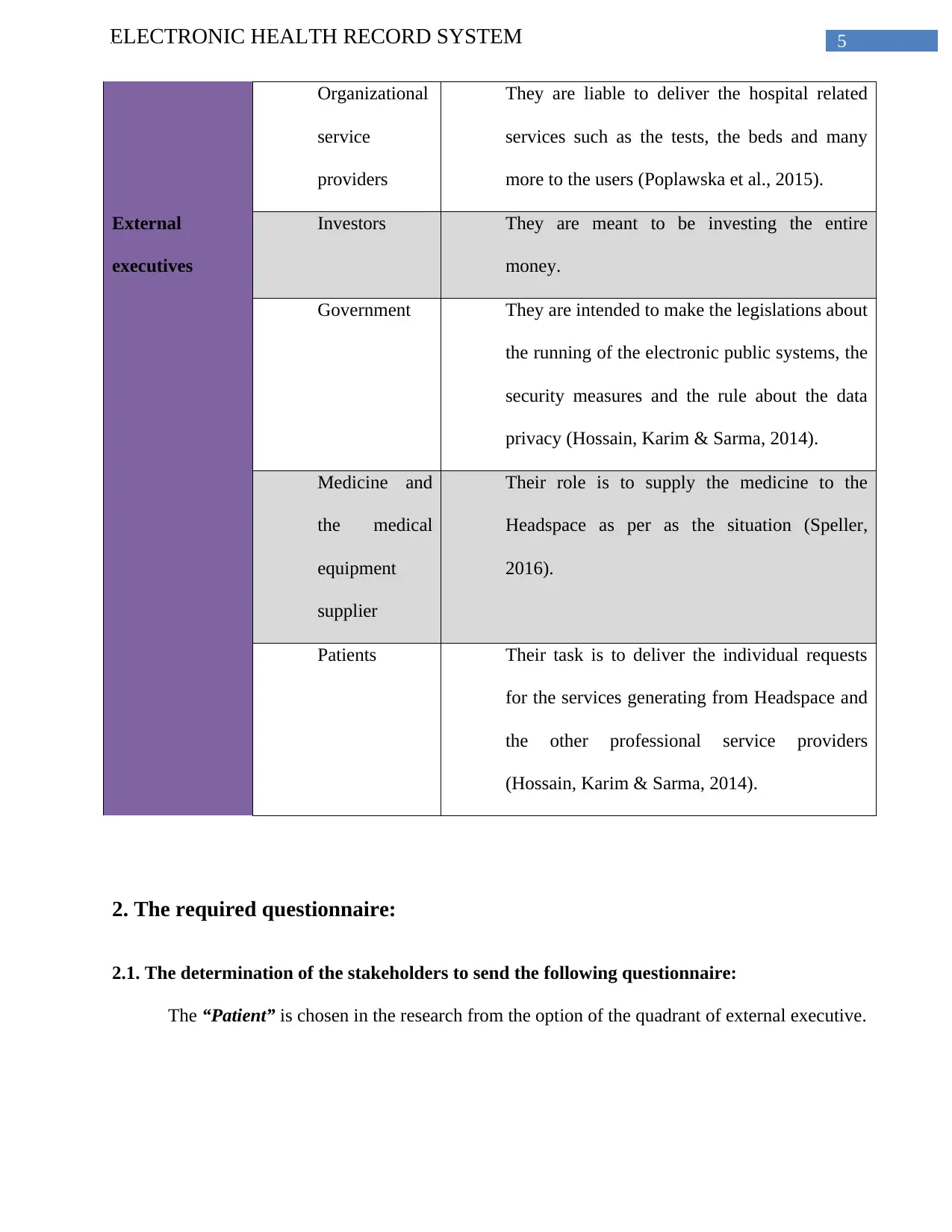
5ELECTRONIC HEALTH RECORD SYSTEM
Organizational
service
providers
They are liable to deliver the hospital related
services such as the tests, the beds and many
more to the users (Poplawska et al., 2015).
External
executives
Investors They are meant to be investing the entire
money.
Government They are intended to make the legislations about
the running of the electronic public systems, the
security measures and the rule about the data
privacy (Hossain, Karim & Sarma, 2014).
Medicine and
the medical
equipment
supplier
Their role is to supply the medicine to the
Headspace as per as the situation (Speller,
2016).
Patients Their task is to deliver the individual requests
for the services generating from Headspace and
the other professional service providers
(Hossain, Karim & Sarma, 2014).
2. The required questionnaire:
2.1. The determination of the stakeholders to send the following questionnaire:
The “Patient” is chosen in the research from the option of the quadrant of external executive.
Organizational
service
providers
They are liable to deliver the hospital related
services such as the tests, the beds and many
more to the users (Poplawska et al., 2015).
External
executives
Investors They are meant to be investing the entire
money.
Government They are intended to make the legislations about
the running of the electronic public systems, the
security measures and the rule about the data
privacy (Hossain, Karim & Sarma, 2014).
Medicine and
the medical
equipment
supplier
Their role is to supply the medicine to the
Headspace as per as the situation (Speller,
2016).
Patients Their task is to deliver the individual requests
for the services generating from Headspace and
the other professional service providers
(Hossain, Karim & Sarma, 2014).
2. The required questionnaire:
2.1. The determination of the stakeholders to send the following questionnaire:
The “Patient” is chosen in the research from the option of the quadrant of external executive.
⊘ This is a preview!⊘
Do you want full access?
Subscribe today to unlock all pages.

Trusted by 1+ million students worldwide

6ELECTRONIC HEALTH RECORD SYSTEM
2.2. The introduction statement:
The introduction statement has been relevant to the questionnaire supplied. This statement
has been explaining the reason behind the development of the questionnaire. The statement is shown
below.
“In order to determine the systems or the solutions needed from the project, the set of
questions are made. The basic objective of the activity is to recognize the functionalities. They have
been helpful as the suggested application is taken into consideration. These questions are developed
from the expertise of technical consultants. This is helpful to understand the detail perquisites as
proposed. There have been ten particular questions to deliver the general comments. The responses
could be anonymously and the respondents would possess the option to provide the contact
information.
Thanks to everyone, for taking your time and responding to the questions”
2.3. The relevant questions to the patients:
1. Is there any scope to extend the duration of treatments as required?
2. Are you all satisfied enough with surfing the site?
3. Do you have enough trust on Headspace?
4. In order to access the sites have your decisions been given priority?
4. Has there been any type of functionalities needed within the system?
6. Can you mention some of the functionalities needed in the system?
7. Has the system of the online payment been useful?
8. Have there any logging-in and registration options provided within the system?
2.2. The introduction statement:
The introduction statement has been relevant to the questionnaire supplied. This statement
has been explaining the reason behind the development of the questionnaire. The statement is shown
below.
“In order to determine the systems or the solutions needed from the project, the set of
questions are made. The basic objective of the activity is to recognize the functionalities. They have
been helpful as the suggested application is taken into consideration. These questions are developed
from the expertise of technical consultants. This is helpful to understand the detail perquisites as
proposed. There have been ten particular questions to deliver the general comments. The responses
could be anonymously and the respondents would possess the option to provide the contact
information.
Thanks to everyone, for taking your time and responding to the questions”
2.3. The relevant questions to the patients:
1. Is there any scope to extend the duration of treatments as required?
2. Are you all satisfied enough with surfing the site?
3. Do you have enough trust on Headspace?
4. In order to access the sites have your decisions been given priority?
4. Has there been any type of functionalities needed within the system?
6. Can you mention some of the functionalities needed in the system?
7. Has the system of the online payment been useful?
8. Have there any logging-in and registration options provided within the system?
Paraphrase This Document
Need a fresh take? Get an instant paraphrase of this document with our AI Paraphraser
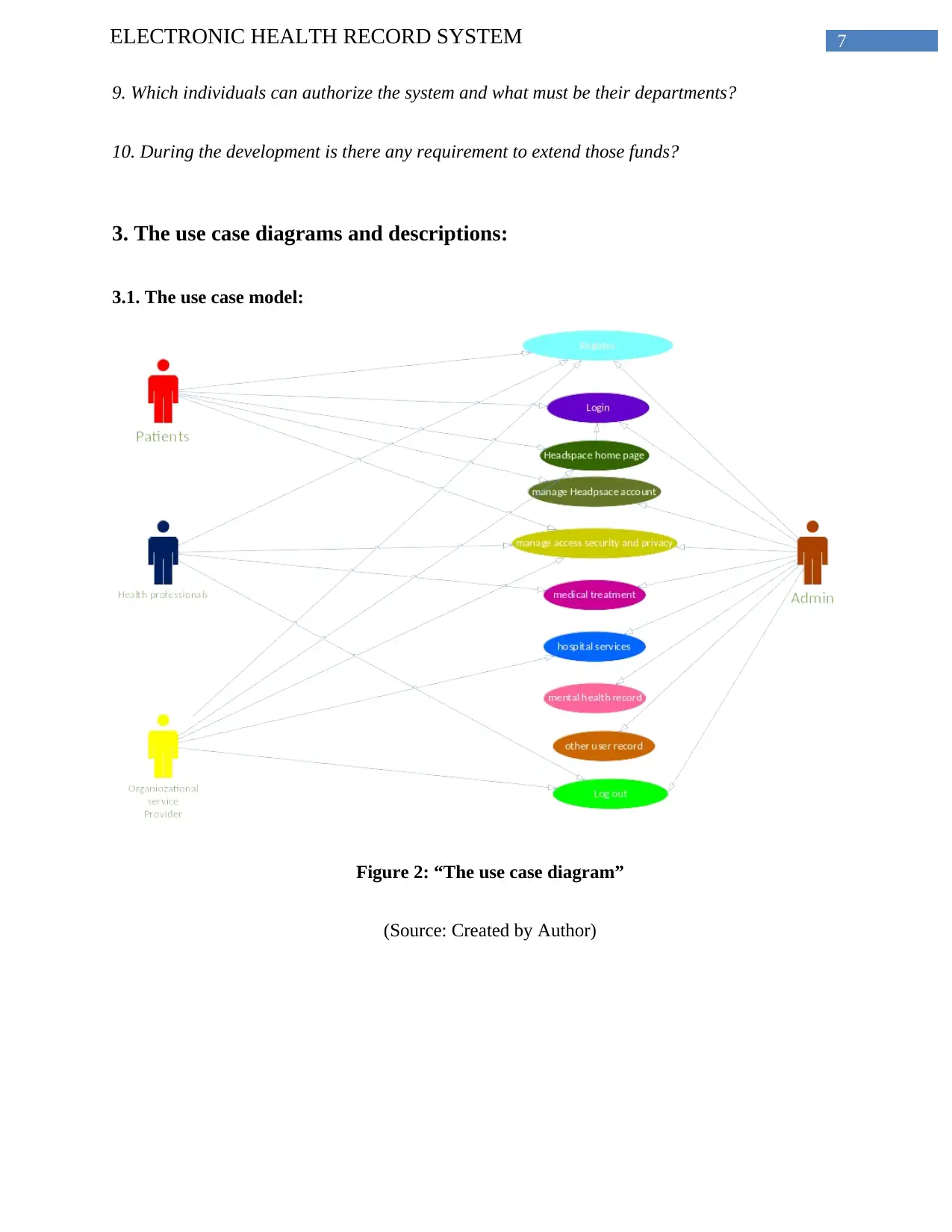
7ELECTRONIC HEALTH RECORD SYSTEM
9. Which individuals can authorize the system and what must be their departments?
10. During the development is there any requirement to extend those funds?
3. The use case diagrams and descriptions:
3.1. The use case model:
Figure 2: “The use case diagram”
(Source: Created by Author)
9. Which individuals can authorize the system and what must be their departments?
10. During the development is there any requirement to extend those funds?
3. The use case diagrams and descriptions:
3.1. The use case model:
Figure 2: “The use case diagram”
(Source: Created by Author)
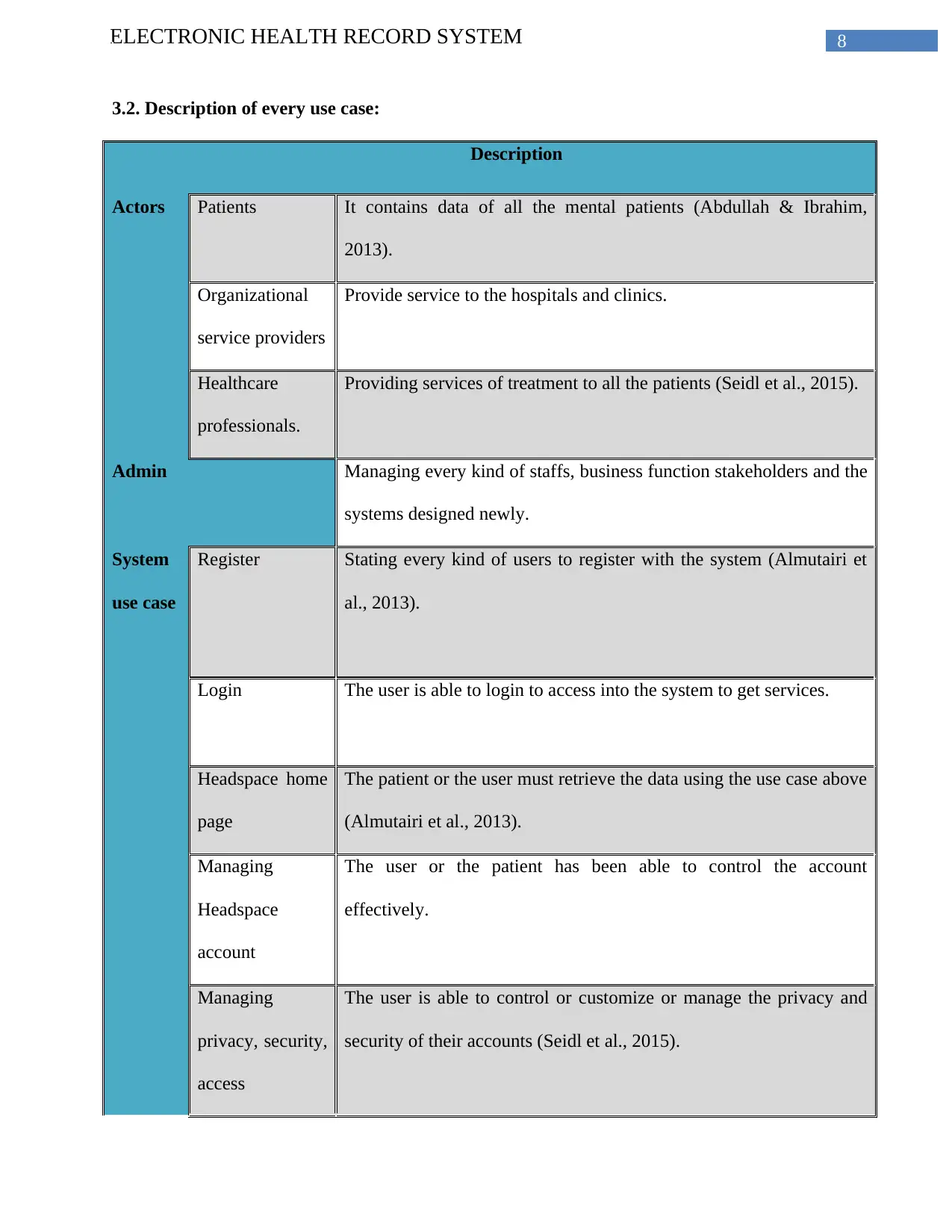
8ELECTRONIC HEALTH RECORD SYSTEM
3.2. Description of every use case:
Description
Actors Patients It contains data of all the mental patients (Abdullah & Ibrahim,
2013).
Organizational
service providers
Provide service to the hospitals and clinics.
Healthcare
professionals.
Providing services of treatment to all the patients (Seidl et al., 2015).
Admin Managing every kind of staffs, business function stakeholders and the
systems designed newly.
System
use case
Register Stating every kind of users to register with the system (Almutairi et
al., 2013).
Login The user is able to login to access into the system to get services.
Headspace home
page
The patient or the user must retrieve the data using the use case above
(Almutairi et al., 2013).
Managing
Headspace
account
The user or the patient has been able to control the account
effectively.
Managing
privacy, security,
access
The user is able to control or customize or manage the privacy and
security of their accounts (Seidl et al., 2015).
3.2. Description of every use case:
Description
Actors Patients It contains data of all the mental patients (Abdullah & Ibrahim,
2013).
Organizational
service providers
Provide service to the hospitals and clinics.
Healthcare
professionals.
Providing services of treatment to all the patients (Seidl et al., 2015).
Admin Managing every kind of staffs, business function stakeholders and the
systems designed newly.
System
use case
Register Stating every kind of users to register with the system (Almutairi et
al., 2013).
Login The user is able to login to access into the system to get services.
Headspace home
page
The patient or the user must retrieve the data using the use case above
(Almutairi et al., 2013).
Managing
Headspace
account
The user or the patient has been able to control the account
effectively.
Managing
privacy, security,
access
The user is able to control or customize or manage the privacy and
security of their accounts (Seidl et al., 2015).
⊘ This is a preview!⊘
Do you want full access?
Subscribe today to unlock all pages.

Trusted by 1+ million students worldwide
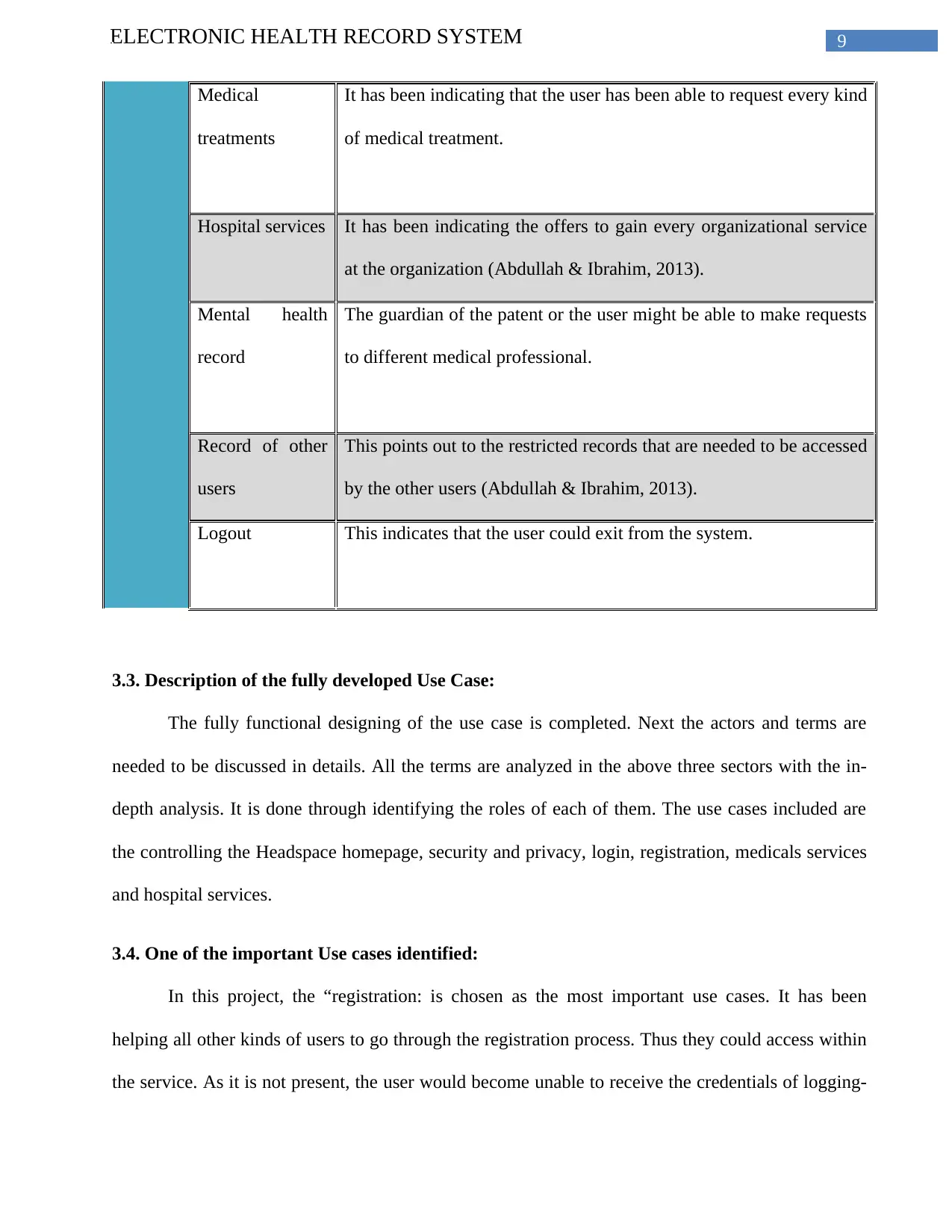
9ELECTRONIC HEALTH RECORD SYSTEM
Medical
treatments
It has been indicating that the user has been able to request every kind
of medical treatment.
Hospital services It has been indicating the offers to gain every organizational service
at the organization (Abdullah & Ibrahim, 2013).
Mental health
record
The guardian of the patent or the user might be able to make requests
to different medical professional.
Record of other
users
This points out to the restricted records that are needed to be accessed
by the other users (Abdullah & Ibrahim, 2013).
Logout This indicates that the user could exit from the system.
3.3. Description of the fully developed Use Case:
The fully functional designing of the use case is completed. Next the actors and terms are
needed to be discussed in details. All the terms are analyzed in the above three sectors with the in-
depth analysis. It is done through identifying the roles of each of them. The use cases included are
the controlling the Headspace homepage, security and privacy, login, registration, medicals services
and hospital services.
3.4. One of the important Use cases identified:
In this project, the “registration: is chosen as the most important use cases. It has been
helping all other kinds of users to go through the registration process. Thus they could access within
the service. As it is not present, the user would become unable to receive the credentials of logging-
Medical
treatments
It has been indicating that the user has been able to request every kind
of medical treatment.
Hospital services It has been indicating the offers to gain every organizational service
at the organization (Abdullah & Ibrahim, 2013).
Mental health
record
The guardian of the patent or the user might be able to make requests
to different medical professional.
Record of other
users
This points out to the restricted records that are needed to be accessed
by the other users (Abdullah & Ibrahim, 2013).
Logout This indicates that the user could exit from the system.
3.3. Description of the fully developed Use Case:
The fully functional designing of the use case is completed. Next the actors and terms are
needed to be discussed in details. All the terms are analyzed in the above three sectors with the in-
depth analysis. It is done through identifying the roles of each of them. The use cases included are
the controlling the Headspace homepage, security and privacy, login, registration, medicals services
and hospital services.
3.4. One of the important Use cases identified:
In this project, the “registration: is chosen as the most important use cases. It has been
helping all other kinds of users to go through the registration process. Thus they could access within
the service. As it is not present, the user would become unable to receive the credentials of logging-
Paraphrase This Document
Need a fresh take? Get an instant paraphrase of this document with our AI Paraphraser
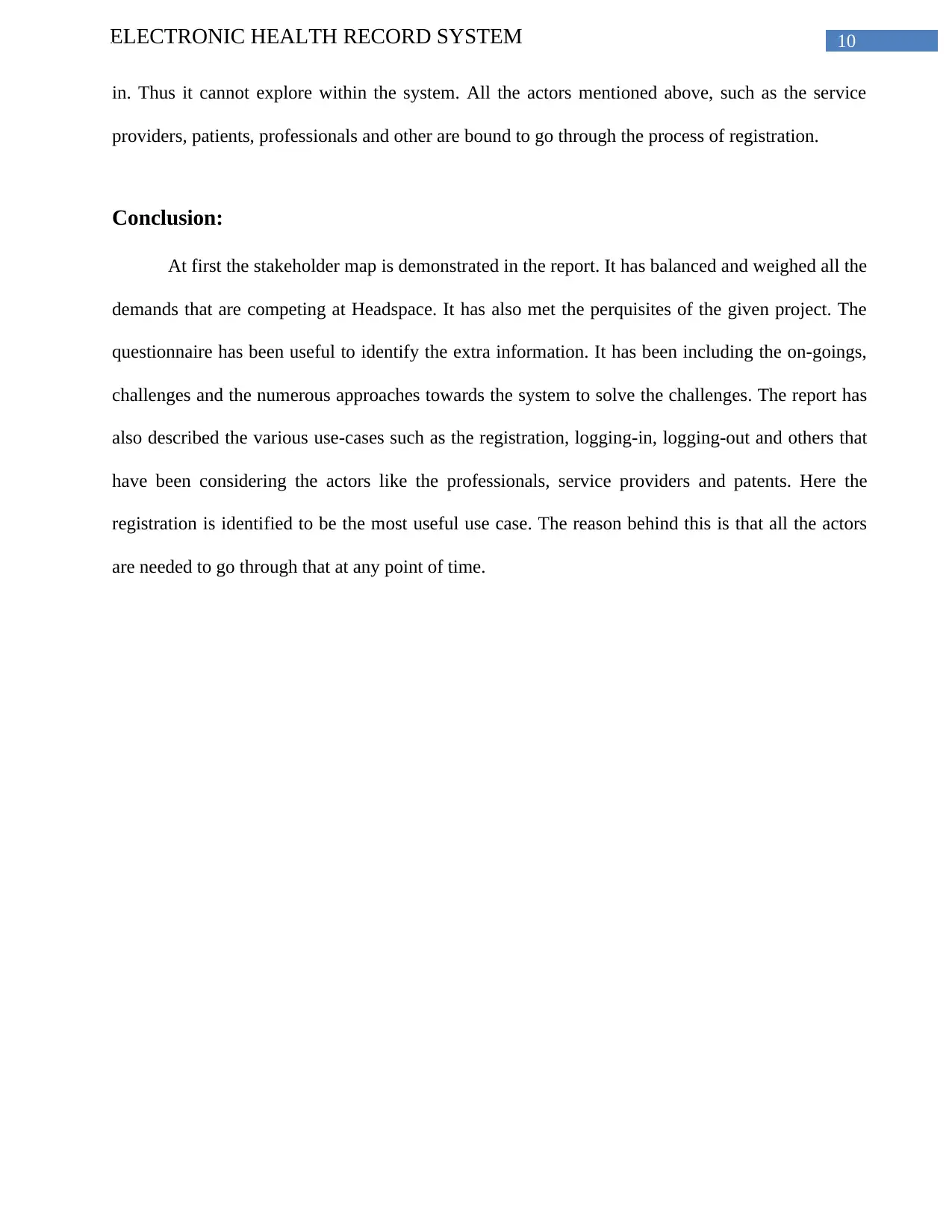
10ELECTRONIC HEALTH RECORD SYSTEM
in. Thus it cannot explore within the system. All the actors mentioned above, such as the service
providers, patients, professionals and other are bound to go through the process of registration.
Conclusion:
At first the stakeholder map is demonstrated in the report. It has balanced and weighed all the
demands that are competing at Headspace. It has also met the perquisites of the given project. The
questionnaire has been useful to identify the extra information. It has been including the on-goings,
challenges and the numerous approaches towards the system to solve the challenges. The report has
also described the various use-cases such as the registration, logging-in, logging-out and others that
have been considering the actors like the professionals, service providers and patents. Here the
registration is identified to be the most useful use case. The reason behind this is that all the actors
are needed to go through that at any point of time.
in. Thus it cannot explore within the system. All the actors mentioned above, such as the service
providers, patients, professionals and other are bound to go through the process of registration.
Conclusion:
At first the stakeholder map is demonstrated in the report. It has balanced and weighed all the
demands that are competing at Headspace. It has also met the perquisites of the given project. The
questionnaire has been useful to identify the extra information. It has been including the on-goings,
challenges and the numerous approaches towards the system to solve the challenges. The report has
also described the various use-cases such as the registration, logging-in, logging-out and others that
have been considering the actors like the professionals, service providers and patents. Here the
registration is identified to be the most useful use case. The reason behind this is that all the actors
are needed to go through that at any point of time.
1 out of 11
Related Documents
Your All-in-One AI-Powered Toolkit for Academic Success.
+13062052269
info@desklib.com
Available 24*7 on WhatsApp / Email
![[object Object]](/_next/static/media/star-bottom.7253800d.svg)
Unlock your academic potential
Copyright © 2020–2025 A2Z Services. All Rights Reserved. Developed and managed by ZUCOL.




